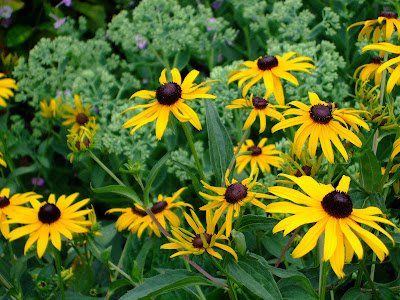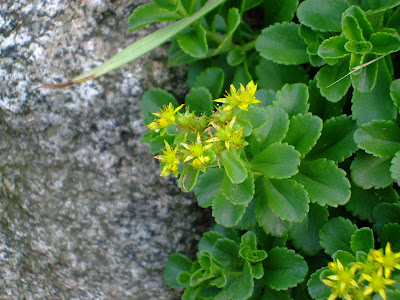Wow, I missed July's Garden Blogger Bloom Day!
I'm ashamed to admit that I haven't been paying much attention to my garden lately; I really wasn't aware what was blooming. (wow, that's just terrible.) Maybe I've been thinking about work too much and am oblivious to anything else. Maybe it's because it's been so ridiculously hot these last few weeks (90*F / 32*C and higher with humidity that makes it feel like 100*F / 38*C or more) that you are so focused on getting from the air conditioned car to the air conditioned house as quick as possible that anything in between those two points is just a blur.
Well, whatever the reason, there are things blooming in my garden so let's get on with the pictures!
~~~~~~~~~
Platycodon grandiflorus, or Balloon Flower. I'm not sure which variety this is (it was a gift) but I do know it is the tall species (3 feet / 1 meter tall).
Hosta 'Patriot'. The flowers look a little messy this year.
Phlox paniculata 'David', or David Tall Garden Phlox. They seem significantly short than in previous years. I wonder why?
Rudbeckia fulgida 'Goldstrum', Goldstrum Black-eyed Susan. Going strong as ever.
Phlox paniculata unknown species. This pinkish-purple Tall Garden Phlox was supposed to be another one of David, but was apparently mislabeled at the garden center. So, we have an extra-tall misfit in the garden.
Chrysanthemum, Hardy Garden Mum. Our patch of cheery yellow mums are just beginning to open.
Echinacea purpurea 'Magnus' & 'White Swan'. The Magnus and White Swan Coneflowers are in full force on the hill.
Perovskia atriplicifolia, Russian Sage. Always impressive and a favorite of bees.
Alcea sp. Common Hollyhock. Our hollyhock flower show was so-so this year. There are still some late bloomers working their way up the flower stalk.
Heuchera species unknown, Coralbells. With all the Heuchera cultivars in production, it's nearly impossible to identify which one you have!
Hemerocallis fulva, Orange Daylily, Tawny Daylily, Ditch Lily (take your pick!) Our Tawny Daylilies bloomed great guns again, as usual. Too bad the flowers don't last too long. But we still have some late bloomers to enjoy!
Sedum kamtschaticum, Stonecrop sedum. I can never spell that name correctly the first time. The stonecrop on the boulder wall are still plugging away. I can't wait for them to change color in the fall.
~~~~~~~~~
So, those were the perennials blooming right now. It turned out to be quite a list! Now, on to the shrubs.
Hydrangea arborescans 'White Dome'. The White Dome Hydrangea haven't given up the flower ghost yet, despite being the battle ground of an epic cat fight between a stray and my Puddy Cat (she may be 15 years old with dull teeth and no front claws, but she victoriously defended her castle!)
Hydrangea paniculata 'White Diamonds'. This is one of the infamous hydrangea that have been trampled by siding and gutter installers, encased in three feet or more of heavy snow, and one being pruned back within an inch of its life by a not-so-helpful gardening helper. The two by the steps have recovered quite well, the over-pruned one has lots of new growth and a few flowers, and the fourth one is just stunted for some reason - I think it needs to be relocated. In any case, I sure hope these ill-fated shrubs have seen the last of their misfortunes.
~~~~~~~~~
But let's not forget the annuals!
Dorotheanthus 'Mezoo Trailing Red', Mezoo Trailing Red Livingstone Daisy. I love love LOVE this plant; it is the Wonder Plant. Once you use it, you will never go back to variegated vinca vine ever again. Mezoo is a succulent-type that can be either a ground cover or a trailer in your annual containers. It loves to be dry and hot. (While in Spain I saw a non-variegated variety of this growing in the driest, hottest, harshest, most neglected conditions imaginable, and it was thick and lush and as happy as can be.) And, unlike variegated vinca that is just a few super long tendrils with a pair of leaves every foot or so, Mezoo is a thick, wide mass of tightly-packed variegated waxy leaves that just grows and grows. And if the foliage wasn't enough to give merit to this plant, in late summer it is covered in dainty fuchsia-pink daisy-like flowers. Find it. I promise you'll love it.
Petunia 'Dreams Red'. I bought these Petunias on mid-season discount. They are more bushy than I would have liked for the windowbox, but they keep on blooming and have great color.
Cuphea 'Bat Face', Bat Face Mexican Heather. The name says it all. It's one of my new favorite plants. Bat Face is a great filler for containers and never stops blooming.
Dianthus sp, & Lobelia 'Techno Heat Dark Blue'. The Annual Carnation is a great repeat bloomer with large flowers that make themselves known. The Techno Heat Dark Blue Lobelia has hardly been fazed by our stretch of excessive heat. I really love that the Techno Heat series has introduced more colors.
Portulaca 'Sundial Mix', Sundial Mix Moss Rose. Another plant that loves to be hot and dry. These have never stopped blooming since we planted them in May.
~~~~~~~~~
In addition to all these intentionally-planted plants, we do have some surprises hiding about in the garden.
Helianthus annuus, Annual Sunflower. Having a few of these pop up is inevitable when you have bird feeders.
Viola tricolor, Pansy. This little guy is the result of last year's pansies self-seeding. I think there is more than one plant here, because the spent flower just to the right was orange. Fun!
Carthemus tinctorius, Safflower. Again, thanks to the bird feeders.
Asclepias syriaca, Common Milkweed. It's hard for Common Milkweed to be a surprise find in your garden once it's become established. The surprise was that there were still some blooming. (I have already snapped off the seed pods; I'm not going to have a repeat performance of last year!)

































.jpg)
.jpg)

.jpg)
.jpg)
.jpg)
.jpg)
.jpg)
.jpg)
.jpg)